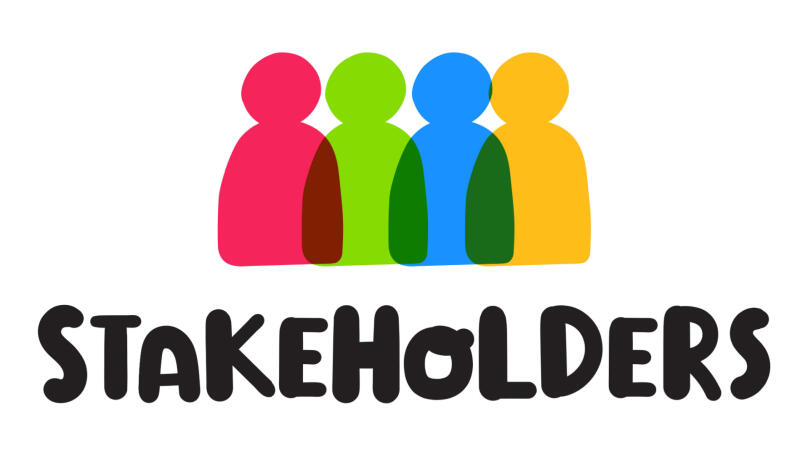Stakeholder

What are stakeholders, and how did they come to be?
Stakeholders are individuals, groups of people or entire organisations that have a certain influence on a business and expect some kind of results from it. In other words, stakeholders are all those involved in the company's activities, so they can be called interested parties. First of all, they include those who work on the project directly - managers and employees, for example. In addition, the definition of stakeholders covers owners and investors whose money is invested in the business, partners who the company collaborates with, as well as suppliers, customers, market participants, communities, government agencies and mass media outlets. A large enterprise may have hundreds of stakeholders, so entire departments are created to identify, analyse and interact with them. For example, PepsiCo - a food industry corporation - is a stakeholder in all business projects where it is an investor. Other market participants may also be stakeholders: McDonald's competitors are a stakeholder group that needs to be taken into account when new strategies are crafted.
Though this term has emerged fairly recently, stakeholders appeared at the time business did. However, it was only in the second half of the 20th century that scholars came to realize that the success of companies directly depended on the relationships with and influence exerted by all interested parties. So, a theory emerged that any company is a part of the environment where it exists, which it impacts and - in its turn - is influenced by. Later, the American philosopher Edward Freeman wrote a book Strategic Management: A Stakeholder Approach where he elaborated the concept of stakeholders and a scholarly approach to their analysis. He argued that in order to achieve an entity's goals, it is essential to factor in the interests of all parties involved in the business. That is, the company should strive to not only make a profit, but also to satisfy the needs of those affected by its activities. According to Freeman's concept, it is essential to competently manage stakeholders and their interests. Only then will they contribute to business growth and progress, and help you minimize external threats.
Shareholder vs. Stakeholder
What is the difference between a shareholder and a stakeholder? A shareholder is the owner of shares and a participant in a joint stock company entitled to receive profits from its operations. They have a vested interest in the company's success, of course, and therefore they are also stakeholders.
Thus, a stakeholder is a broader concept that covers all shareholders, regardless of the number of shares held or any other criteria. In other words, every shareholder is a stakeholder, but not every stakeholder is necessarily a shareholder. As we have already established, stakeholders are all parties in any way involved in the company activities, who have a vested interest in its success and are able to exert their influence.
Types of stakeholders

Stakeholders may be classified in a number of ways, for example, by the way of interacting with them:
1. Internal stakeholders
They are all people directly involved in the entity's operations. Their interest in the success of the business is the most understandable and obvious one, because they are the company employees, top managers, executives and shareholders. However, it is essential to realise that each stakeholder pursues their own objectives though they all work towards a common goal. For example, a shareholder strives for more decision-making authority, a manager seeks to minimise production costs, and a rank-and-file employee is interested in the company success that will translate into higher salaries.
2. External stakeholders
They are parties directly unrelated to the entity, but influencing its performance in indirect ways, for example, competitors, government agencies, mass media outlets and banks. That is, they do not participate in the entity's operations, but thanks to their capabilities, they can significantly impact them. For example, a company's activities may get adverse coverage in the mass media outlets, in which case the impact will be negative. But if a popular blogger recommends the brand's new product on their social media platform, this will contribute to the inflow of new customers.
In addition, stakeholders are categorised according to the level of their influence and interest:
1. Primary or key stakeholders
Primary or key stakeholders - company partners, suppliers and managers, for example - significantly influence the entity and are involved in its operations on an ongoing basis. That is, the company simply cannot exist without these stakeholders. Their interests should not be neglected in order to avoid significant losses of the company resources.
2. Secondary, or arm's length stakeholders
These stakeholders are not directly related to the company, they do not participate in its operations, do not have any contractual relations with it, but are still able to exert significant influence on it. This group includes, for example, the authorities, public figures, activists, and customers.
You should keep in mind that each stakeholder has a specific social role and is therefore able to influence the company. Thus, stakeholders are also categorised according to their areas of interest or social roles:
- buyers and customers;
- users;
- suppliers;
- developers;
- producers, etc.
Stakeholder management

Stakeholder management and analysis comprises several stages:
Stage 1. Identifying stakeholders
This process can also be called identification of all parties interested in the company activities. In order to identify stakeholders, it is essential to carefully analyze the business processes, review the company's recently signed contracts, agreements, covenants and other documents that mention the key stakeholders.
Stage 2. Analyzing stakeholders and identifying their individual interests
Analyzing project stakeholders is a key part of the entire stakeholder management process. Once all stakeholders are identified, they should be categorised into specific groups based on the levels of their influence and interest:
- most influential and most interested;
- least influential and least interested;
- influential but not interested;
- interested, but with low influence.
To this end, it is essential to carefully review the company's closest and broader environment and determine how much influence each actor has and how interested they are in the company activities. In addition, this stage involves a detailed description of the most important and influential stakeholders in terms of their needs, expectations and wishes.
Stage 3. Developing a stakeholder management strategy
It is then necessary to craft the tactics of interacting with all project stakeholders based on the earlier obtained information about their interests, management objectives and requirements. This will help you design a rational system of priorities: the more important a stakeholder is to the company, the more time and attention they should get with a view to consolidate relationships with them.
A successful stakeholder management strategy generally depends on how actively and effectively the company interacts with them. The key objective is to fulfill the stakeholder expectations and goals. To this end, entities need to capture their interests, consistently engage with the stakeholders through an interaction plan, and increasingly meet their needs and expectations.
Stage 4. Implementing the plan and analyzing stakeholder management outcomes
At this stage, contacts are established with the project key stakeholders. Simply put, it involves implementing the stakeholder interaction strategy developed earlier. Some time down the road, the relationship between the company and some stakeholders may become stronger and more productive provided the strategy has been developed properly. But it may also be ineffective and create unreasonable expectations of a stakeholder or make them change their opinion of the company. In addition, stakeholders get involved - at this stage - in management activities and decision-making to ensure that the interests of all groups are realised.
Stage 5. Updating information and regularly repeating all steps of the process
This stage involves a review of the stakeholder management programme and problem solving, if any. This may comprise surveys and obtaining feedback, including that on stakeholder satisfaction. It is important to keep in mind that the levels of influence and interest of all stakeholders are not static. It is a dynamic variable that can change rapidly. For example, previously unimportant actors may suddenly gain enormous influence and become more active stakeholders. Therefore, stakeholder data needs to be updated regularly and the entire process - from stakeholder identification to analysis - needs to be repeated.
Stakeholder analysis

Stakeholder analysis is the most extensive and energy-consuming stage in stakeholder management. There are special marketing tools to simplify the process. The most effective and efficient ones among them are the following:
-
Stakeholder map
A stakeholder map is a visual tool enabling to identify all stakeholders in a project, a company or an organisation. It helps to get a 360° view of the project, assess the influence each party exerts, and determine how to interact with them to ensure the project's successful completion. The map features three circles, i.e. three specific areas:
- authority and responsibility (the stakeholders closest to the company and its management who follow their orders and act according to the requirements, i.e. employees);
- direct influence (those who interact with the company on mutually beneficial terms, for example, suppliers, contractors and partners);
- indirect influence (that is, there is no direct interaction between the company and the parties in this area, for example, government agencies, mass media outlets and competitors).
So, each identified stakeholder is located in one of the three circles. This method helps organize information about stakeholders and facilitate decision-making that takes into account the interests of them all.
-
Support and influence matrix
It is a visual tool for mapping the levels of stakeholder influence and their attitude to the company as well as designing a stakeholder interaction strategy. The stakeholder analysis matrix looks like a table featuring four cells (quadrants). In order to competently fill it, you should evaluate each stakeholder according to two criteria: importance and influence. The former means the level of stakeholder's interest in the company, and the latter reflects the extent of their influence and impact.
Each quadrant of the matrix captures certain indicators. For example, the key stakeholders, i.e. investors, managers and so on should be in the first one. They are the stakeholders that the company values and relies on the most.
The second quadrant features the parties that are not as important as its investors and managers, for example, its employees and partners. They can gradually transition to the first quadrant, becoming indispensable for the company.
The third quadrant presents dissatisfied employees - that is the stakeholders more skeptical about the project. And the fourth one features mainly competitors - in some cases they may be mass media outlets and government agencies. Thus, the stakeholder analysis matrix allows project managers and company executives to see which stakeholders are important for the project success, which ones can help them, and which ones can create problems.
-
Stakeholder interest table
The stakeholder interest table is also used in project management to identify their interests and needs. It helps to visualize which groups of people have an interest in the project and what their goals, expectations and needs are, thus providing a more accurate idea about their role in the project. In addition to general stakeholder data, it comprises the following criteria:
- the project impact on the stakeholder (the assessment results can be expressed by letters: H - high, L - low or M - medium);
- the stakeholder involvement in or influence on the project (also the letters H, L or M);
- needs and requirements (what the stakeholder needs and what is most important to them);
- expectations (what outcomes the stakeholder expects, what actions and communications they expect);
- level of interest (which group the stakeholder belongs to: 1 - company allies, 2 - just supportive, 3 - neutral, 4 - reluctant participants, 5 - opponents);
- the company impact on the stakeholder (H, L or M);
- potential risks and problems;
- strategy for involving the stakeholder in the project;
- communications (the way the stakeholder interacts with the company).
It is important to keep in mind that as the project develops and the parties' needs change, the stakeholder interest table should be updated and revised. This way it will become a useful tool for managing the project and ensuring that all stakeholders are satisfied in the process.
Anyway, each of these marketing tools has its advantages. The stakeholder map, for example, focuses on capturing all stakeholder groups and their interaction with each other. So, it helps to identify their social roles as well as to assess their influence on the project success. The matrix, on the other hand, aims to properly categorize stakeholders based on their interests in the project. And the table of interests provides more information about the goals, problems and hazards associated with the stakeholders. This helps to craft an efficient strategy for communicating with all groups and stakeholders.
To sum up, interaction with stakeholders is an important part of business development, because it is not just a profit generating tool, but also an opportunity to make the world around us better, to meet the needs and fulfill the desires of a certain number of people. Stakeholder interaction also offers obvious practical benefits: they help you monitor product quality, manage risks, and minimise or even prevent adverse influence. Managers who take into account the opinions and interests of all the stakeholders are usually interested in achieving the long-term success of the entire business or a particular project. Stakeholder support and influence assessment also helps the work team to identify the company's strengths and weaknesses, maintain effective business relationships and develop sound promotional strategies.























